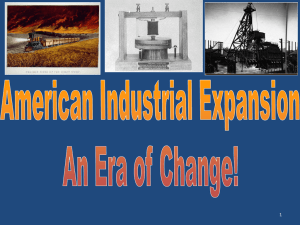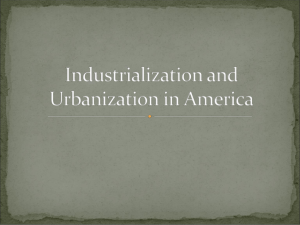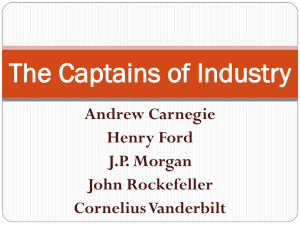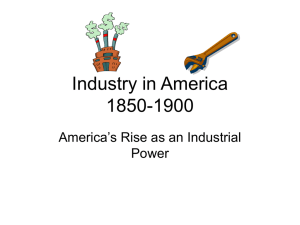SHEF--Oil Steel RR - Ithaca Public Schools
advertisement
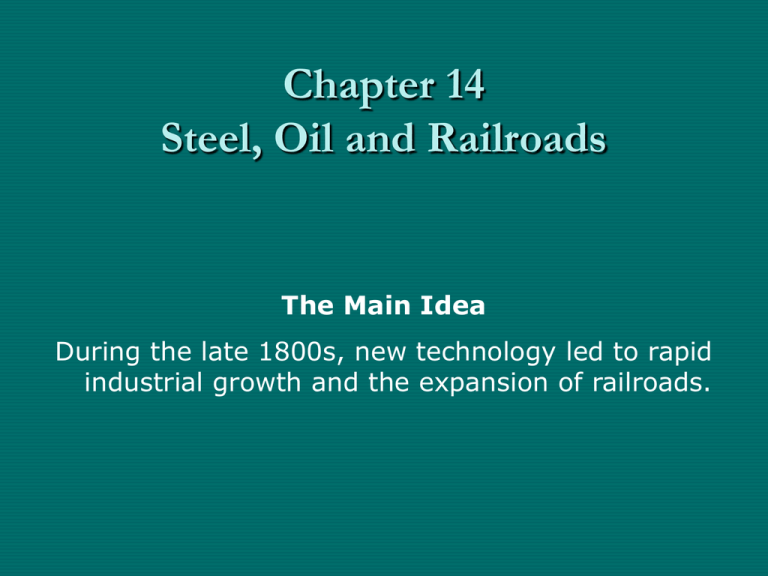
Chapter 14 Steel, Oil and Railroads The Main Idea During the late 1800s, new technology led to rapid industrial growth and the expansion of railroads. New Industries Emerge • New technologies – Electrical power replaced steam and water power. – Larger factories produced more and more goods. – Faster transportation moved people and goods more cheaply. • Dramatic industrial growth – Period sometimes called the Second Industrial Revolution New Industries Emerge Making Steel • Bessemer Process of purifying steel. – helped to make America the world’s top producer – transformed the U.S. into a modern industrial economy. – William Kelly created the idea in the United States. =Construction companies could build bigger bridges and taller buildings, locomotives and steel rails. =The low cost of steel made ordinary items affordable. STEEL STEEL • Definition • Uses / Innovations • Process • Impact of industry importance Steel is an alloy of iron with about 1-2 percent carbon. IRON STEEL CAST IRON Uses Chicago Making Steel • Bessemer Process of purifying steel. – helped to make America the world’s top producer – transformed the U.S. into a modern industrial economy. – William Kelly created the idea in the United States. =Construction companies could build bigger bridges and taller buildings, locomotives and steel rails. =The low cost of steel made ordinary items affordable. Bessemer Process Changed everything – cheap consistent steel IMPACT OF STEEL Cities went vertical. Railroads were built everywhere Vertical Integration • • • • • • Mines Trains Ships Coal Coke ovens Steel mills Andrew Carnegie—STEEL •Rose from Scottish immigrant child to steel magnate. •Used profits from various business investments to found own company and buy out rival steel producers. •By 1901 the Carnegie Steel Company dominated the U.S. steel industry. US Steel Corporation. •After retiring, devoted his time to charity, supporting education and building public libraries. Andrew Carnegie -Made steel process efficient Sold company Become insanely rich--- Gave most away – 90% + Stevens Point got a library. …and then tore it down. Worker unrest – safety concerns – Unions form You tell me… Railroads Cornelius Vanderbilt—RAILROADS •Vanderbilt began investing in railroads during the Civil War. •By 1872, he owned the New York Central Railroad. •At the height of his career he controlled 4,500 miles of track. •He supported few charities, but gave money to what would come to be Vanderbilt University. •He died leaving an estate of $100 million. Railroads Expand—More Tracks • 1865 to 1890, the number of miles of railroad track increased nearly fivefold. – 1860=30,000 miles – 1890=180,000 miles • To aid the growth, the federal government gave thousands of acres of land to railroad companies. TRANSCONTINENTAL RAILROAD Union Pacific • Laid tracks westward from Omaha, Nebraska • Prairie lands and gently rolling hills made for quick progress. Central Pacific • Tracks were laid eastward from Sacramento, California. • Chinese workers laid tracks through tougher terrain, crossing deserts and blasting through mountains. = May 18, 1869= The two lines met. United the country physically and economically. Golden Spike. East ---West Connection Communication TIME ZONES - Organization Corruption Railroad Productivity Land Grants • The first major railroad land grants originated with the 1862 legislation that enabled the transcontinental railroad. At that time, the Union Pacific and Central Pacific railroads were granted 400-foot right-of-ways plus ten square miles of land for every mile of track built. • P.460 • Depending on sources, 9.5% to 17% of all US lands were given/ controlled by railroads. George Pullman—Pullman, IL •Made his fortune designing and building sleeper cars that made long-distance travel more comfortable. •He built a town south of Chicago to house workers in relative comfort, believing happy workers were more productive. •The Pullman Company controlled aspects of life in the town, and criticism was not tolerated. Effects Of Railroad… •Promoted trade and provided jobs. •Boosted steel industry and train manufacturers. •Contributed to the growth of the modern corporation. •Gave industrialists quick and inexpensive access to distant markets and distant sources of raw materials. Effects Of Railroad… •Settlement of the West was easier. •Sparsely populated areas began to fill with residents. •New towns were founded and existing ones expanded. •Led to the adoption of standard time. New Industries Emerge Oil industry begins • Oil was a key commodity as a fuel source and for lubrication. • Edwin L. Drake drilled the first commercial oil well. Oil prospectors, or Wildcatters, looked for oil in other regions. • Major sources of energy from oil fueled a revolution in transportation and industry. OIL • • • • Historical Origins / uses US origins Impact / Innovation Problems 347 AD First oil 1846 – first mechanical well First oil Titusville Signal Hill Spindletop By introducing the world's first commercial oil well in 1859, Edwin Drake launched an oil boom in Western Pennsylvania comparable to the California gold rush of '49. First uses • 3,000 years of use – – – – – Lamp oil Medicine Seal boats Generally a nuisance • 150 years modern oil industry Impact – New energy economy • 20 to 1 energy ratio • Nothing like it. Kerosene, not gasoline- first oil use Products today • • • • • • • • • • Petrochemicals (Plastic) Asphalt Diesel fuel Fuel oils Gasoline Kerosene Liquefied petroleum gas (LPG) Lubricating oils Paraffin wax Tar • Some of biggest companies in the world John D. Rockefeller—OIL •Starting with an oil refinery and superb business sense, used both vertical and horizontal integration to capture 90% of the U.S. oil refinery business by 1879. •Standard Oil Trust—consisted of 40 corporations that controlled every phase of oil refining. – 1913 gave away over half of his fortune to charity. – He donated millions to education and good works through his Rockefeller Foundation. John D. Rockefeller Started Standard Oil Created refinery monopoly Also insanely rich from oil How rich is insanely rich? • • • • • Name: John D. Rockefeller Age at Highest Earnings: 74 Age at Death: 97 (died May 23, 1937) Net Worth: ▬ 329.9 Billion $USD Original Net Worth: US$1 Billion (September 29 1916)[2] US$900.0 Million (1913-eve of WWI) [3] • Origin: United States • Main Source of Wealth: Standard Oil • Other Achievements: First Billionaire (Globally-USD)[4] and The Rockefeller Foundation (Created:1913)[5] The Auto Industry- Car Culture Highway system Car culture Suburbia- Daily Gas usage by country Relative Gas Prices Future of Oil Problems • • • • • Non-renewable Major pollutant Most “not” in US No price controls WE NEED IT!!!!!! A Mixed Legacy Critics – Business tycoons were “robber barons” who profited unfairly by squeezing out competitors. – They lived lavish lifestyles from their ill-gotten rewards. Proponents – Business tycoons were “captains of industry” who used their business skills to make the American economy more productive. – That in turn made the American economy stronger. A Favorable Climate for Business Free Markets • Capitalism= competition determines prices and wages, and most industries are run by private businesses. • In the 1800s, business leaders believed in laissez-faire capitalism with no government intervention. • Entrepreneurs risked their money and talents in new ventures. Proprietorships and Partnerships – Small businesses were run by individual proprietors or had more than one owner in a partnership. – In either case, owners are personally responsible for all business debts and obligations. Corporations – As industries grew, the structure of ownership changed. – Businesses were owned by stockholders; decisions made by a board of directors, with day-to-day operations run by corporate officers. – Investment money was raised by selling stock, and investors were bound only by the amount of their investment. Trusts and Monopolies – Some companies merged and turned their stocks over to a board of trustees who ran the group of companies as a single entity. – Sometimes a trust gained a monopoly, having complete control of an industry. – With no competition, prices could be raised or lowered at will. Social Darwinism • Economic life was controlled by the natural law of competition (survival of the fittest) • Agreed with the well-known economist, Adam Smith’s ideas of the law of supply and demand. • Businessmen liked the ideas of capitalism, they actively sought to eliminate competition and control the free market. • John Rockefeller and Andrew Carnegie.

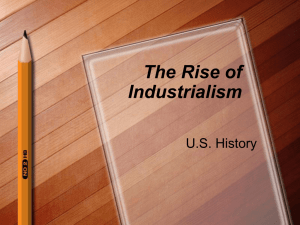
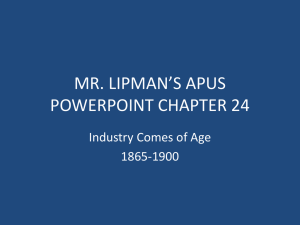
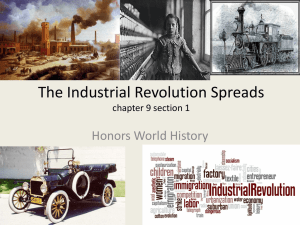
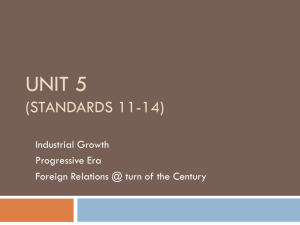
![men_who_built_america[1]](http://s2.studylib.net/store/data/005219845_1-7979604da89ac700f7913bb56611cc41-300x300.png)
